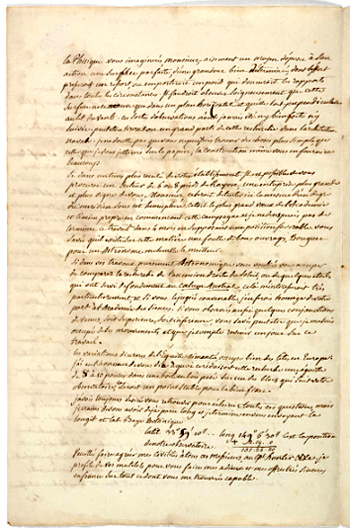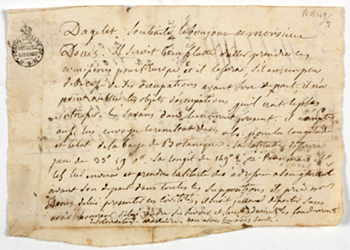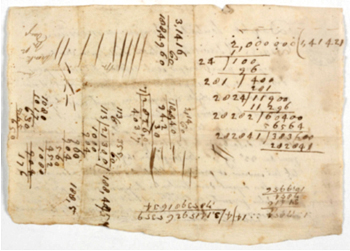Era: 1788 Cultural background: French Collection: Mitchell Library, State Library NSW Theme:Communication Cook First Fleet Military Science Settlement

Joseph Dagelet’s letter to William Dawes, c.1788. Courtesy State Library of New South Wales, p.1
Collection
State Library of New South Wales, Sydney, Australia
Object Name
Letter
Object/Collection Description
A letter from Joseph Lepaute Dagelet (1751-1788), astronomer from the Lapérouse Expedition to William Dawes (1762-1836) astronomer to the First Fleet and British Settlement at Port Jackson. Dimensions: approximately 250mm wide x 300mm long.

Joseph Dagelet’s letter to William Dawes, c.1788. Courtesy State Library of New South Wales, p.2

Joseph Dagelet’s letter to William Dawes, c.1788. Courtesy State Library of New South Wales, p.3

Joseph Dagelet’s letter to William Dawes, c.1788. Courtesy State Library of New South Wales, p.4
The exploration of the Pacific was a massive task, which took over three hundred years. The Pacific expansion began with the search for new trade routes to the Far East. Between 1768 and 1842 more than twenty expeditions traversed the Pacific searching for new resources and collecting scientific data. Maps needed to be updated.
French interest in the Pacific stemmed from the curiosity of Enlightenment scientists and navigators in the thousands of unknown islands and the mysterious Great South Land. These places were thought to be inhabited by strange plants, animals and populated by people who were different to any other nation of the time. During the 1600s the new frontier was extending to the south. All of the major European countries were players in the exploration of the Southern Hemisphere.
The existence of Terra Australis or ‘Land of the South’ was mooted by various navigators and little by little evidence of its existence was mounting. Slowly contact was made, first by the Spanish led by Luis de Torres in the north, who sailed through the straits between New Guinea and Cape York in 1606. The Dutch came next with Janzoon (1606) in the west and Abel Tasman (1642) in the south at Van Diemans land. The Dutch mapped parts of the continent naming it New Holland, but showed no further interest. The navigator to search for coast of Terra Australis was France’s Louis Antoine de Bougainville who in 1768 approached the Great Barrier Reef off the coast of North Queensland but was turned away by the surf.
England’s James Cook expedition to the south Pacific finally established that there was a land of the South. After completing the observation of the transit of Venus across the Sun at Tahiti in 1769, Cook set off to explore the south Pacific. After exploring New Zealand and establishing that it was two islands and not the Land of the South, Cook sailed further west. In April 1770 Cook sailed onto the east coast of Australia. In a simple ceremony at Botany Bay, Cook named the coastline New South Wales. Cook extensively mapped the Pacific during three expeditions between 1768 and 1779. Single handedly Cook opened up the Pacific revealing a lot of its secrets.

Atlas du Voyage de Lapérouse, 1785 -1788. Photograph Stephen Thompson.
Inspired by the voyages of Cook, King Louis XVI of France commissioned Lapérouse to explore the Pacific as no one had done before. Cook’s charts were used and the Lapérouse expedition is one of the great voyages of discovery. Lapérouse departed Brest, France, in command of L’Astrolabe and La Boussole on 1 August 1785.

The map of the route of Lapérouse to Botany Bay, 1785 -1788. Photograph Stephen Thompson
After extensively mapping and recording the coastlines of North America, Japan, Korea and Siberia, Lapérouse was directed by the French government to go to Botany Bay to observe the founding of the British Colony by the First Fleet. On 26 January 1788 Lapérouse arrived at Botany Bay, just as the British were leaving for Port Jackson. The commander of the Fleet, Captain Phillip, ordered that two British naval vessels, Sirius and Supply, meet the French. Contrary to popular belief, the French did not have orders to claim Australia for France.
‘We spent the whole of the 24th (Jan 1788) plying in sight of Botany Bay, but that day we had a spectacle; this was the British Squadron at anchor with their pennants and ensigns which we could plainly distinguish’.
Lapérouse Journal, 1788.
The French stayed at Botany Bay for six weeks and built a stockade, observatory and a garden for fresh produce on the La Perouse peninsula. At Botany Bay Dagelet undertook calculations on map position of Botany Bay, carried out astronomical observations and met with William Dawes at Port Jackson. Dawes volunteered for service with the First Fleet and sailed on the Sirius. From February 1788, he was employed on shore to build an observatory at Dawes Point. Following this meeting Dagelet sent a letter to Dawes (1762-1836) with advice to Dawes on setting up his observatory, resent work on the fluctuations of the Earth’s magnetic field and calculations on maps positions of Botany Bay.
The last official sighting of the French expedition was in March 1788 when British lookouts stationed at the South Head of Port Jackson saw the expedition sail from Botany Bay. The expedition was wrecked on the reefs of Vanikoro (Melanesia) in the Solomon Islands during a cyclone sometime during April or May 1788. The fate of the expedition was to remain a mystery for nearly 40 years.
The letter has historical significance as evidence of France’s push into the Pacific and keen interesting the settlement of Botany Bay. The collection is significant as evidence of the place where the First Fleet landed and the subsequent meeting of the British, French and aboriginal people. The collection also has historical significance as France’s 1988 bicentennial gift to Australia.
The letter is significant for researchers as it is one of the few existing European documents and objects surviving related to early colonial Botany Bay and French exploration.
The letter is well provenanced to State Library of New South Wales. It was donated to the library by a Mr Wesley in 1915.
The letter is unique.
The letter represents a time when France was beginning its push into the Pacific to rival the influence of Britain. The collection also reflects the precarious nature of sea journeys, navigation and shipping in the late 18th century.
The letter is in excellent condition for its age and material.
The letter interprets the story of the Pacific exploration, the Lapérouse expedition and their meeting with the First Fleet at Botany Bay in 1788 and the development of 19th century Australian colonial values and consciousness to the world. The collection interprets the reverence the La Pérouse site has had for France since 1788.
Bibliography
Sydney.
Coupe, S & Andrews, M 1992, Their Ghosts may be heard: Australia to 1900,Longman Cheshire, Sydney.
Dunmore, J 1994, The Journal of Jean- Francois de Galaup de La Pérouse. 1785 -1788. Vol 1 & 2. London.
Heritage Collections Council 2001, Significance: A guide to assessing the significance of cultural heritage objects and collections, Canberra.
Thompson, S 2002, Lapérouse Museum booklet, Dept Environment & Conservation.
Thompson, S 2005, Any News of La Pérouse?, Exhibition catalogue essay, State Library of New South Wales.
Thompson, S 2004, Atlas du Voyage de Lapérouse, Exhibition catalogue essay, Dept Environment & Conservation.
Thompson, S 2007, At the Beach: Contact, Migration & Settlement in South East Sydney, Migration Heritage Centre, Sydney.
Websites
Migration Heritage Centre
June 2007 – updated 2011
Crown copyright 2007©
The Migration Heritage Centre at the Powerhouse Museum is a NSW Government initiative supported by the Community Relations Commission.
www.migrationheritage.nsw.gov.au
Regional Services at the Powerhouse Museum is supported by Movable Heritage, NSW funding from the NSW Ministry for the Arts.
State Library of NSW
www.sl.nsw.gov.au




